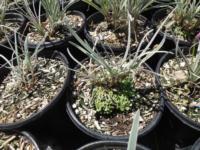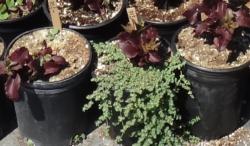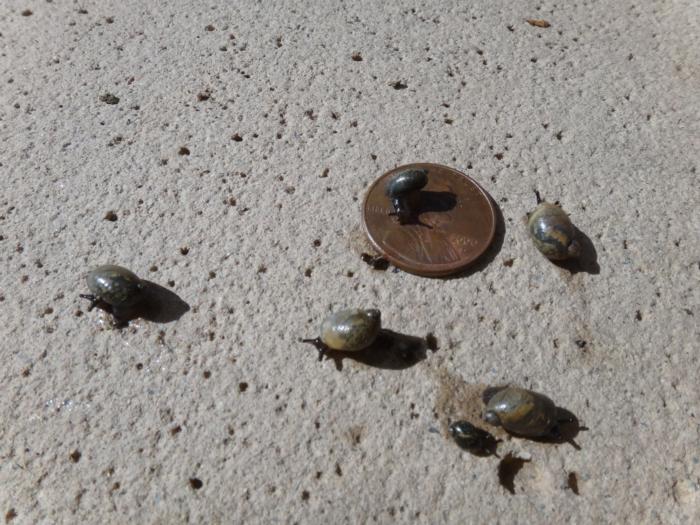Scouting for snails and slugs
by Cheryl Wilen
Snails and slugs feed on a wide variety of plants in nurseries. Monitoring for these pests is important, not only to prevent economic losses due to crop damage, but also because quarantine regulations impact plants shipped out of state as well as some intrastate locations. Common snail and slug species found in nurseries include the brown garden snail (Cornu aspersum, formerly Helix aspersa), amber snail (Succinea spp.), gray garden slug (Deroceras reticulatum, formerly Agriolimax meticulatus), banded slug (Lehmannia poirieri) and the greenhouse slug (Milax gagates).
Both snails and slugs are members of themollusk phylum and are similar in structure and biology except slugs lack the snail's external spiral shell.

Adult brown garden snails (fig. 1) lay about 80 spherical, pearly white eggs (fig. 2) at a time into a hole in the topsoil. Although the eggs are white initially, as they develop they turn brown and may be mistaken for some brands of slow-release fertilizer. Brown garden snails may lay eggs up to six times a year.

Fig. 2. Brown garden snail eggs are pearly whiteand may be found in clusters in the media along the inside of the pot. Photo: C. Wilen.
Snails and slugs are most active at night and on cloudy or foggy days. On sunny days they seek hiding places out of the heat and sun. In mild-winter areas such as in Southern California and in coastal locations, young snails and slugs are active throughout the year. During cold weather, snails and slugs hibernate in the topsoil. During hot, dry periods, snails seal themselves off with a parchment-like membrane and often attach themselves to the outside of pots, tree trunks, fences, or walls.
Snails and slugs often hide but frequently can often be found attached to the outsides of pots. Slugs and snails constantly secrete mucus, which later dries to form the silvery "slime trail" that indicates the presence of these pests. The scout should be on the lookout for these trails. Other clues to their presence include feeding damage on plants (holes in the leaves) and, for some species, spiraling feces. Amber snails (fig. 3) are more difficult to detect as they are generally small (2-20 mm long) and tend to live on the media surface. Look for these snails in the pots and at the interface of wet and dry areas between the media and the container. Slugs tend to be found underneath the containers and often in the media. Slug eggs are difficult to find, but the eggs of the brown garden snail can sometimes be found in the container media, often along the inside of the pot in clusters of about 10 to 50 eggs (fig. 2). Typically these are not noticed until the plants are sized up to larger containers.

When monitoring for snail and slugs, the scout should check the pots by moving them, especially if can tight. Plants should be inspected frequently especially if the plants have leaves that are close to the stem where snails can hide during the day. Also inspect around the beds, including pieces of wood or stakes, near weeds and under the edges of the nursery mat.
In addition to visual observations, an effective method for sampling snails and slugs is by trapping these pests under 12-by-15 inch boards (or any easy-to-handle size) raised off the ground by 1-inch runners. The runners make it easy for the pests to crawl underneath when they seek a cool, moist location during the day. By positioning the boards around the nursery or greenhouse, one can get an idea about population pressure and hot spots. However, this method will not work for amber snails, which live on the pot media.
Another method of monitoring that is effective for the brown garden snail is to place an attractive bait containing metaldehyde in small piles strategically around the growing areas. Nearby snails will be drawn to the bait overnight and will quickly die. The next morning, the number of dead snails can be counted to get an idea of the about population pressure and hot spots as described above. If you have dogs wandering the nursery, place the metaldehyde in a way that it is accessible to the snails but not the dogs, such as in a commercial bait trap.
For more information, see the Floriculture and Nursery Pest Management Guidelines from UC IPM at http://ipm.ucanr.edu/PMG/r280500111.html
Cheryl Wilen is UC Cooperative Extension Area Integrated Pest Management Advisor, Los Angeles, Orange and San Diego Counties, and UC Statewide IPM Program; and Endemic and Invasive Pests and Diseases Initiative Leader.












